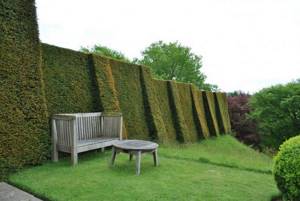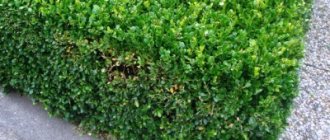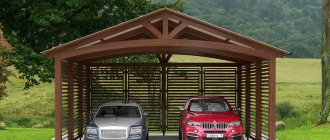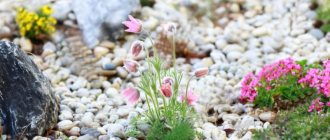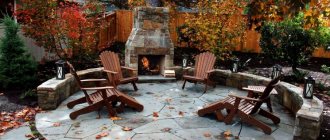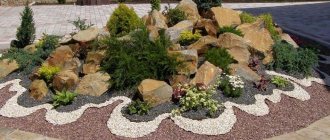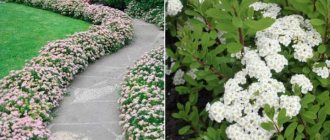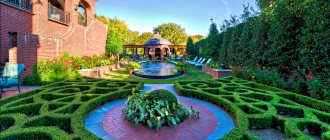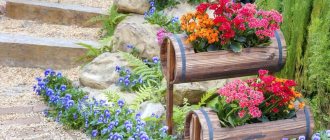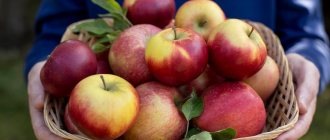Living plants
Evergreen hedges not only protect from indiscreet views, but also limit access to winds and serve as an effective biofilter that purifies the air.
The main thing is to feel comfortable
Green fences with windows and a passage decorated in them look very original. They are created using metal gratings or trellises and various wooden structures.
Tips for creating a plant fence
Landscaping is a serious undertaking. To make the composition look harmonious, all plants should be carefully selected according to color and preferences. In addition, trees can be not only beautiful, but also functional. For example, a house in an open area can be protected with a living fence made of coniferous plants, which will protect the owner of the site from the cold wind. If the house is used only as a summer cottage, it is enough to plant deciduous trees. They will bloom and delight the eye in the spring. To protect against animals, you should pay attention to thorny varieties (barberry).
The first decision you need to make is what to plant in your garden for a living fence. All such designs can be divided into several varieties:
- green borders - fences up to 0.5 m in height, which are used not only around the perimeter of a summer cottage, but also to decorate flower beds or paths (boxwood, magnolia, heather);
- fence - a structure up to 2.5 m that will protect from the wind and create shadow near the fence;
- a green wall is a fence higher than 2.5 m, planted to fully enclose the site.
The owner of a property with a living fence should learn all the intricacies of tree pruning. If the crown is not formed and neatly trimmed, the hedge will look untidy.
Which hedge is better?
However, when creating a fence from green spaces, it is necessary to take into account at least the basic rules and recommendations in the construction of such significant elements of the site.
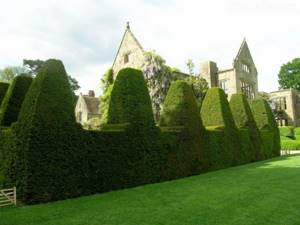
It is important to take into account all recommendations when planning
For example, one of the main rules is that the fencing must correspond completely to the general style of the interior space of your site, for example, a garden.
Bamboo is used in a Japanese-style garden, while vine is appropriate for a rustic-style garden. Pergola is used for climbing crops.
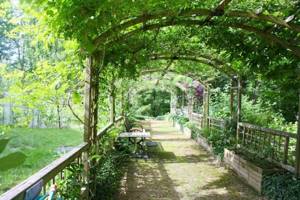
Pergola in the country is used for climbing crops
Deciduous, beautifully flowering and decorative-leaved shrubs, as well as tall herbaceous perennials will protect you from prying eyes in the summer season.
If you don’t have time to create a permanent hedge, make it from plantings in tubs. The best candidates for this role are ball-shaped yew, oleander, hibiscus or hydrangea.
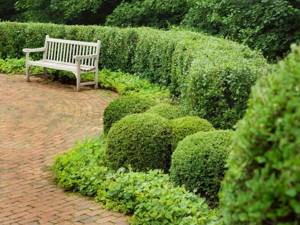
Beautiful yew balls - not difficult and always pleasing to the eye
If you are a fan of annual vines, nasturtium or echinocystis are suitable for you, they can form a hedge within a month and a half after sowing.
A striking red leaf hedge will do well in a clean, open space exposed to sunlight.
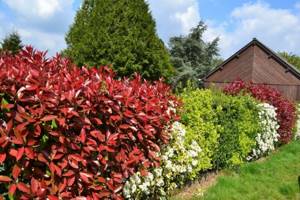
Deciduous shrubs are more often used for free-growing hedges
Loose hedges - how to prune
Plants growing without preliminary formation also need to be put in order.
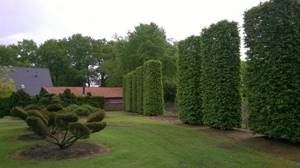
The first cutting is carried out 2-3 weeks after planting to allow the crop to spread out to the sides. The next haircut is best done in the fall. The shoots should be cut lightly so that the bushes grow well in 3-4 years.
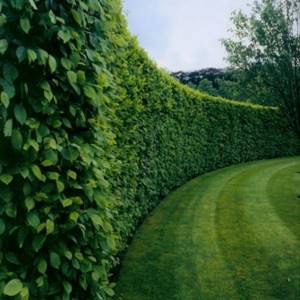
Coppice pruning has proven to work well in practice. It implies:
- Cutting off weak shoots and shortening strong ones in the first year;
- Trimming the stems down to stumps in the second year;
- Cut the stems 3-4 cm higher than the stumps in the third year.
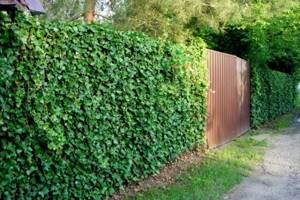
The principle of cutting the third year falls on the following years of bush development. When the bush grows and the branches thicken, the cut occurs at 3/4 of the length.
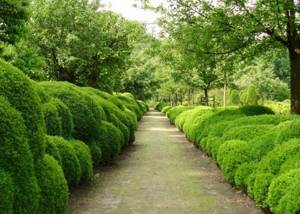
Such care is welcomed by both a free-growing fence and a fast-growing hedge, where medium-sized plants often take place:
- Paniculata hydrangea;
- Shrub cinquefoil;
- Wrinkled Rose;
- Decorative turf;
- Japanese spirea.
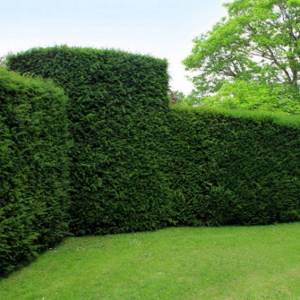
However, coppice pruning has a disadvantage - accelerated formation of root shoots. Because of this, some varieties spread several meters from the mother bush. To avoid this, the root zone must be limited with asbestos-cement sheets.
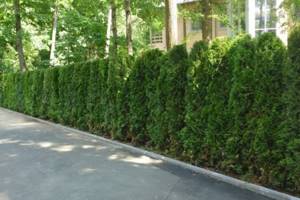
Which plants to choose?
If you are creating a hedge with an eye to the future, take your time and do not buy the first shrubs you come across. When choosing a cultural variety, several factors are taken into account:
- When purchasing your chosen plant breed, find out how big it will grow . For example, different varieties of boxwood evergreen can vary significantly in height. It can reach only one meter in height, or it can reach a height of two and a half meters.
- Try not to choose plant species that are too tall, as gaps may appear in them . Be sure to inquire about the winter hardiness of the selected species. If they freeze, the desired effect will be very difficult to achieve.
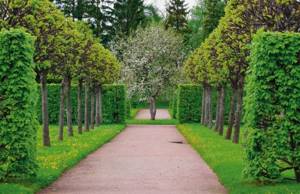
Try not to choose breeds that are too tall
- Find out about the chosen plant, whether it is deciduous or evergreen . If you are outside the city only in the warm season, deciduous species are suitable, as they can change their appearance depending on the season. In spring - gently green hawthorn and linden, golden forsythia, in autumn - warm shades of maple and euonymus.
- Find out what kind of care the selected plant species require. For example, fast-growing thuja is pruned only twice a year, but not more often, and pruning of yew and boxwood should be done only at the beginning of summer. If you want stricter lines, cut it also in March. Evergreen shrubs with large leaves are trimmed only with hand pruners.
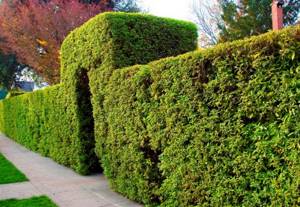
Before planting, you need to know everything about the plant.
Watering and fertilizing
A hedge requires systematic watering. Before the procedure, be sure to loosen the soil on both sides by 60–70 cm. Direct the stream of water to the base of the plants, thereby ensuring moisture to a depth of at least 30–40 cm.
Organic fertilizers are applied in early autumn or spring. At your choice, it can be leaf humus, compost or peat. The amount of fertilizer required is determined at the rate of 2–5 kg of mixture per square meter.
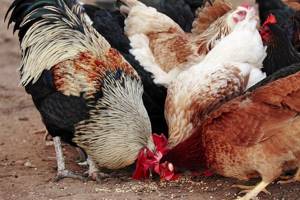
Low price and high concentration have made bird droppings a leader in the organic fertilizer category. Litter cannot be stored; in 2 months, up to half of the nitrogen will evaporate from it.
The application of mineral fertilizers is seasonal: nitrogen fertilizers in early spring, phosphate fertilizers in early autumn or late summer. Autumn bait is carried out with the following composition: 30–45 g of potassium salt, 45–65 g of superphosphate, 40–60 g of ammonium sulfate.
Location
A striking red leaf hedge will do well in a clean, open space exposed to sunlight.
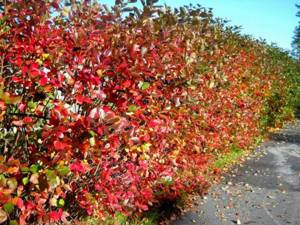
A spectacular hedge on your property
In a dark place, such bright foliage will look gloomy. This applies, for example, to some varieties of European beech or cultivated cherry plum. Plants with golden needles will appear dull on hot days. To avoid unexpected effects, it is better to choose species with bright green leaves.
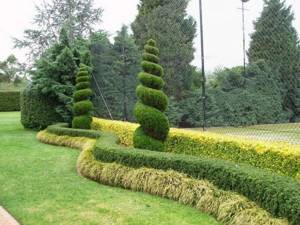
It is customary to use not only planting shrubs
- Due to their bright foliage, maples will decorate your site in the autumn. Among the Far Eastern species, it is worth noting the Manchurian ash, fluffy alder, and beautiful larch.
- Some hedges have thorns and thorns. On the one hand, this scares off some uninvited guests, on the other hand, it creates difficulties in regular maintenance.
- Don't ignore climbing plants either. They grow quickly in both sunny and shady corners of the garden. They entwine trellises, obelisks and pavilions specially built for them.
- Campsis with bright trusses of tubular flowers has proven itself well in landscaping. Pruned oaks, maples, and weeping lindens look great on the plots.
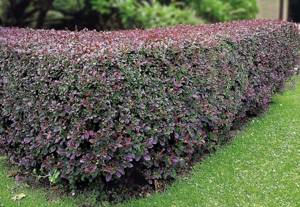
Such shrubs will add a good mood to your dacha
You have the power to turn your hedge into a sea of colors and flowers. You can buy ready-made wooden trellises covered with plants. In just one day, reliable protection from prying eyes will be ready.
Which ones are fast growing?
Vertical gardening is a universal garden decorator that allows you to achieve a stunning effect in a short time.
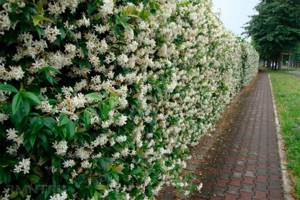
A flowering fence is beautiful at any time of the year
You need to start by selecting supports for the “green wall”, which should decorate the area even without vines. This is important in winter and spring, when supports serve as the only accents of the garden. The choice of plants for vertical gardening is quite rich.
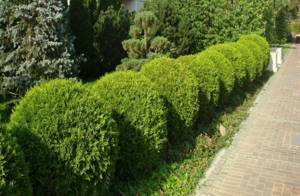
The choice of plants for hedges is large and varied
- The girl’s grapes, which themselves “climb” the wall, look impressive. An unpretentious hop that prefers a shady corner looks beautiful. True, its growth will have to be controlled, otherwise it will displace other crops from the site.
- You can create a decorative green vertical from such annual vines as blood red beans, nasturtium, morning glory.
- Some herbaceous perennials can also create dense, variegated walls of flowers. Willow sunflower reaches two and a half meters, and rudbeckia and elecampane can grow up to three meters.
- For climbing plants such as roses, morning glory, clematis and others, it is advisable to build some kind of support, and do not forget to tie up the plants from time to time. Not all specimens need to be tied up.
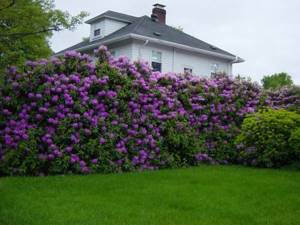
Looks very impressive and floral
Plants such as Kobea and Campsis just need to be planted near the support. Blue delphinium flowers will delight you on a wall 1.7 meters high. Lavatera, hollyhock, and buzulnik can reach approximately the same height.
A hedge of fast-growing crops
Perennial hedges look quite impressive thanks to their careful formation. To reach a height of one and a half meters, the thuja needs to grow for 5 years, the yew – 8 years. These crops attract with their appearance all year round.

Decorative grass - 140 photos of original design. Review of the best varieties of grass for the garden, instructions, reviews, videos + gardener recommendations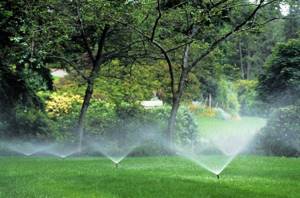
Watering the site - types and types of systems, main differences and features, rules for selection and installation, as well as recommendations for operation
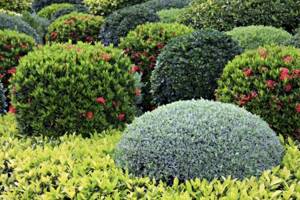
Ornamental plants - 140 photo options. Review of the most popular plants with names and descriptions. Gardener's recommendations + reviews
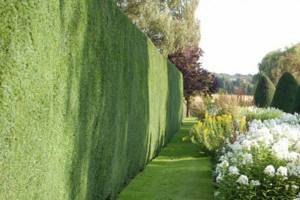
Other shrubs grow by 0.5-1 m per year:
- Blackberry;
- Rose hip;
- Siberian hawthorn;
- Climbing Rose;
- Bush willow;
- Deren.
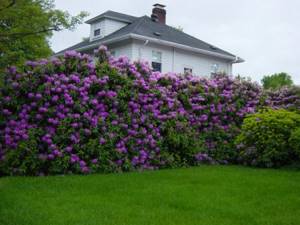
And do not forget that fertilized soil promotes good development. Therefore, before planting seedlings in the holes, it is necessary to add compost with humus (4:1).
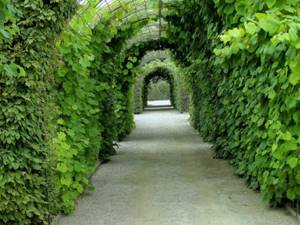
Thuja for hedges
Thuja is quite thermophilic, for this reason it is better to plant it in open ground in March. But in areas with not too cold winters, autumn planting can be done. In this situation, it is important to do it before the soil completely freezes, because the plant simply will not take root. The latest landing date is the second half of October.
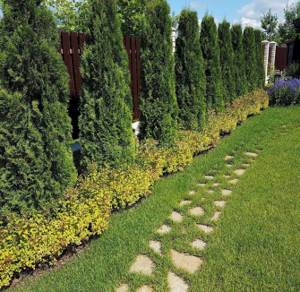
The advantage of this plant is that it does not need too many additives.
How to plant?
When planting, it is advisable to place a couple of buckets of humus at the bottom of the hole; it must be connected to the top fertile layer of soil. In the spring, you need to add about half a kilogram of superphosphate to the same hole. If this component is not available, you can use a kilogram of wood ash.
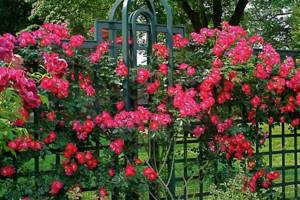
Creating such a bright bush is not so difficult
- If the soil is acidic, lime or dolomite flour is added to it.
- In the pits, drainage is made (15-10cm) from small crushed stone, gravel, broken brick, sand. Then the hole must be filled two-thirds of the volume with the prepared soil mixture.
- If possible, the planting hole should be prepared 10-15 days before planting so that the soil settles well.
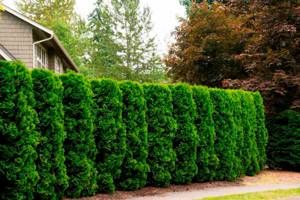
Thuja prefers well-lit places. The plant is not recommended for planting on sandstones and in windy areas.
Growing, pruning and caring for a green hedge is not difficult. If you follow the basic rules and agrotechnical practices, then after 2-3 years the green spaces will serve as reliable and beautiful protection for the site.
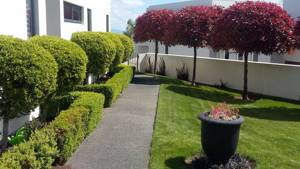
These shrubs are frost-resistant
VIDEO: The best plants for creating a hedge
Creating a hedge
Overview, advantages and disadvantages
Hedge: planting and care
Plants to form a thematic planting must be of the same age. With such seedlings, an even row is guaranteed already in the first years of development.

Landscape designers and gardeners recommend planting 2-3 year old deciduous seedlings. And if the latter are coniferous, then their age must be at least 3 years.
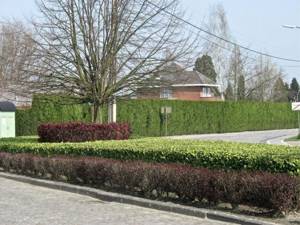
Much depends on the level of lighting in the area: dark places are more suitable for mature, and therefore tall, plants.
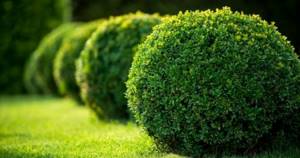
Boxwood: planting, care, growing in open ground, propagation. Full description of the plant from A to Z. More than 100 photos of evergreen shrubs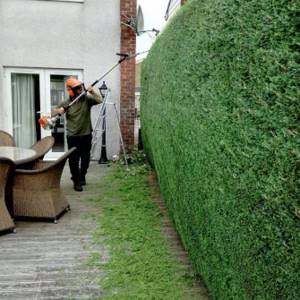
Living fence - the best ideas on what to make a hedge from at your summer cottage. Many photos of ready-made options with exclusive designs + instructions
- Trimming bushes - the basics of choosing the right plants and forming the right shapes, selecting tools (photo + video)
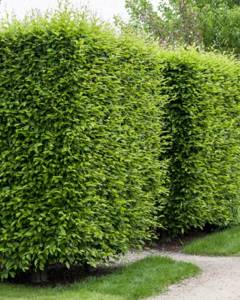
This way the hedge becomes visible already in the first years from the moment of planting. In this case, the distance between seedlings depends on their height:
- High fencing - 0.8-1.2 m in a row and 1 m between rows;
- The average fence is 0.4-0.6 m in a row and 2-3 m between rows.
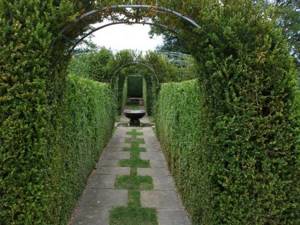
If the hedge is planted in such a way that the plants grow freely, i.e. without cutting, the distance between the rows and inside the rows increases by 1-3 m and 0.8-2 m, respectively.
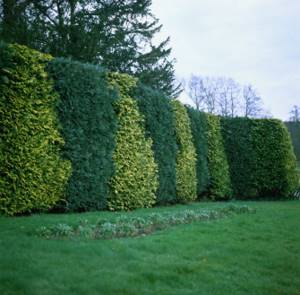
As for planting, it occurs in spring and autumn. On the eve of winter, it is better to deepen seedlings into holes if the region is southern. Accordingly, spring is more suitable for the middle zone.
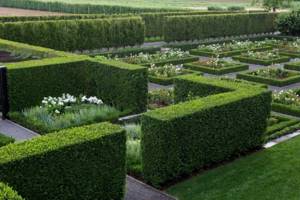
The landing process occurs as follows:
- Places for trenches are marked;
- Half-meter holes are dug;
- Young seedlings are laid out in the holes;
- The holes with roots are filled with a nutrient mixture and compacted;
- The seedlings are watered.
Depending on the species and variety of crop, the top of the soil is periodically mulched so that the root system of the seedling develops quickly. With mulch, green friends grow better because moisture is stored in the soil longer.
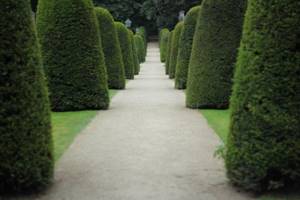
After transplanting, the crop remains to be regularly watered, fed and weeded. Loosening to ventilate the roots is also encouraged.

With the arrival of autumn, the green hedge at the dacha will have to be trimmed to give the plants that have grown over the summer a neat shape.
